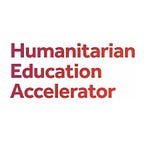Design Series: What can we learn from the design sprint process?
by Ben Webster, CEO & Founder of Mosaik Education
In September this year, Mosaik joined the Humanitarian Education Accelerator (HEA) as one of three organisations selected to be part of the HEA’s Covid-19 Challenge.
As part of the HEA, Mosaik is developing and testing a minimum viable product version of our Open Dogme Toolkit: online training on ‘Dogme’ strategies, facilitation guides for mobile-based teaching, and a community of practice. The Toolkit aims to support English language teachers of refugee youth to maintain the interactive and human side of ELT during Covid-19.
The first step in our HEA journey was our design sprint, supported by IDEO.org, who jumped into the Open Dogme Toolkit team for two weeks to tackle how we might weave the toolkit more effectively into the needs and constraints of teachers’ busy lives. Nathalie, Meg and Justine from IDEO.org were fantastic, guiding us to think through the most pressing challenges and assumptions we needed to test. They also had amazing graphics on their slides (see screenshot below) which brought the whole process to life for the team.
Mosaik has done design sprints previously, but largely through our internal design practice, rarely in partnership with other organisations. Working with IDEO, who are a step removed from Mosaik’s day-to-day activities, helped to bring a fresh approach. Here are our top three learnings from the sprint:
- (Design) Sprints are about focus and speed
A professional sprinter will plan their race in ‘phases’: a 200m sprinter will ‘attack’ the first 40m, ‘glide’ round the bend, then ‘re-accelerate’ in the final straight. During our design sprint, it felt like focus and speed were key factors that progressed in phases.
Our initial discussions with the IDEO team were spent mapping teacher experience and learner experience. However, it became clear that, with the range of work involved in putting together the toolkit, we needed to zero in on a discrete area of design.
Primarily we were supporting teachers, and the biggest hole in our design work so far was the ‘community of practice’. This would be essential to help teachers integrate the training they receive into their daily practice. Once we narrowed our focus, the challenge became clearer and the pace of progress picked up to a ‘sprint’.
This rhythm of widening and narrowing focus is inevitable in design work, as the double diamond design diagram (below) illustrates well. However, choosing what to focus on and when is crucial to making progress in the limited time of a ‘sprint’.
2. Take stock of what you already have
Once we were focussed on the community of practice, we started to map out our existing teacher support processes. For this task, IDEO introduced the ‘storyboarding’ method into the mix, where you draw or describe stages of a process.
Our teacher support for existing programmes had evolved in response to challenges and needs during the Covid-19 pandemic, and whilst we could describe what it was, we had not had a chance to take stock of the process.
We were surprised by how complete it appeared once we stood back and looked at it as a whole. Although it developed fairly organically and, to us, felt quite rough and ready, it gave us a solid blueprint to work with. Outlining the process also revealed that the tight learning loops of the support process were almost as important as the training itself. This process gave us a strong foundation on which to build our broader community of practice design, saving a significant amount of time and work.
3. The value of analogous inspiration
In order to inspire ideas for how to set up and maintain a meaningful community of practice, the Mosaik and IDEO teams brought together other examples of communities. The diversity of experience across the design team members was a fantastic asset in bringing together a range of ideas to inspire our work, from co-working spaces, to open source movements, to Syrian feminist dialogues.
Although Mosaik has used analogous inspiration activities before, this exercise highlighted how crucial it is in creating divergent thinking, and how valuable diverse backgrounds and experiences are in making it successful. It can be incredibly important in generating ideas as well as firming up what you don’t need.
Design sprints are extremely helpful in generating ideas, acting fast and learning quickly. A lot of it is at the team’s fingertips already, but the sprint structures thoughts and reflections. For Mosaik, IDEO’s facilitation was a new experience, and helped Mosaik to be more divergent in thinking and reflective of our own practice.
About Mosaik
Mosaik (www.mosaik.ngo) is a non-profit organisation that supports refugees to reach university,through programmes that focus on academic guidance and English language training in Jordan, Lebanon and Turkey. All of our programmes are co-designed with refugees, leverage technology and are open for local community organisations to lead. This year we reached over 300 young people, despite the Covid-19 pandemic.
